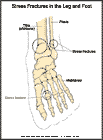
Stress Fractures
What is a stress fracture?
A stress fracture is a hairline crack that can occur in bones from repeated or prolonged use. The most common sites for stress fracture are the foot bones (metatarsals), shin bone (tibia), outer lower leg bone (fibula), thigh bone (femur), and back bones (vertebrae).
How does it occur?
Stress fractures are overuse injuries. The majority of leg injuries occur during activities such as running, jumping, or dancing. Stress fractures of the feet were originally called march fractures because they were commonly seen in military personnel.
What are the symptoms?
You have pain with activity. You may have swelling and bruising.
How is it diagnosed?
Your health care provider will examine you and may order an x-ray. However, x-rays do not always show a stress fracture. Your provider may order a more specialized test called a bone scan.
How is it treated?
The most important treatment for a stress fracture is rest. Other treatment may include:
- applying ice packs over your injury for 20 to 30 minutes every 3 to 4 hours for 2 to 3 days or until the pain goes away
- if you are a runner, running only if there is no pain
- changing your activity, such as from running to swimming
- taking anti-inflammatory medication prescribed by your health care provider
- wearing a cast for 3 to 6 weeks while your bone heals
- surgery, in some cases.
When can I return to my sport or activity?
The goal of rehabilitation is to return you to your sport or activity as soon as is safely possible. If you return too soon you may worsen your injury, which could lead to permanent damage. Everyone recovers from injury at a different rate. Return to your sport or activity will be determined by how soon the fracture heals, not by how many days or weeks it has been since your injury occurred. In general, the longer you have symptoms before you start treatment, the longer it will take to get better.
After a stress fracture you may do sports or activities that do not cause pain. It is very important not to "run through the pain" because this may cause further injury. You should vary your activity for one week at a time. For instance, if you have a stress fracture from running, you should either rest or swim for a week, then attempt to run short distances. If there is no pain, you can gradually increase your distance.
How can I prevent a stress fracture?
Stress fractures are caused by overuse. The best way to avoid getting a stress fracture is to listen to your body and not force yourself to do activities while you are in pain.

